Engaged Anthropology Grant: Cheryl Knott
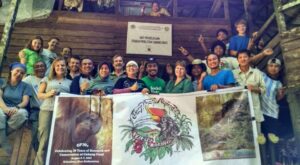
Cheryl Knott is an Associate Professor of Anthropology at Boston University. In 2012 she received a Post-Ph.D. Research Grant to aid research on “Sexual Coercion and Reproductive Strategies in Wild Bornean Orangutans”. In 2014 Dr. Knott received an Engaged Anthropology Grant to aid engaged activities on “Gunung Palung Orangutan Project: 20 Years of Research and Conservation”.
On August 6-7 of 2015, the Gunung Palung Orangutan Project (GPOP), with support from the Wenner-Gren Foundation, hosted the GP30+ Conference to highlight and celebrate over 30 years of research and conservation work at Cabang Panti Research Station in Gunung Palung National Park. Over the past three decades, over 150 foreign and Indonesian researchers have done field work at Cabang Panti, and we have been supported by countless Indonesian academic and government counterparts. GP30+ was the perfect way to bring all of these people together to share research results, make new connections and emphasize the importance of continuing research and education in and around Gunung Palung National Park. The main event was a two- day Symposium, held at the Mahkota Kayong Hotel in Sukadana, appropriately held in the “Gunung Palung” ballroom, and featured presentations from 15 invited speakers. The Symposium, which was open to current and former researchers and field assistants, local government officials, National Park representatives, and area conservation organizations, was attended by over 100 people. Many of the government officials were hearing about the research station and results for the first time. Invited guests included government officials and Indonesian scientists, who came from as far away as Jakarta.
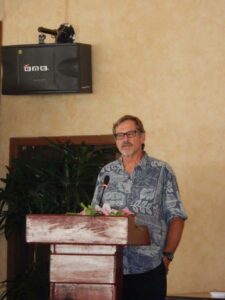
The Symposium opened with welcome speeches from both the Bupati (district head) of Kayong Utara regency and the head of the Gunung Palung National Park Bureau. These opening remarks were followed by a plenary presentation by Dr. Mark Leighton, the founder of Cabang Panti Research Site. He shared the history of the station, from the very first research trip before Gunung Palung National Park even existed to what it has become today. Although Dr. Leighton spoke in English, everyone, even our Indonesian guests who aren’t fluent in English, had a great time looking at his old photos and listening to the stories about the early days of research at
Cabang Panti. The morning session on August 6th continued with a series of presentations about orangutan research in GPNP, with talks by primatologist Dr. Cheryl Knott (founder of GPOP and the Gunung Palung Orangutan Conservation Program, GPOCP), Wahyu Susanto (Research Director, GPOP), Andrea DiGiorgio (Ph.D. student, Boston University), and Taufiq Purnama (Indonesian Institute of Sciences).
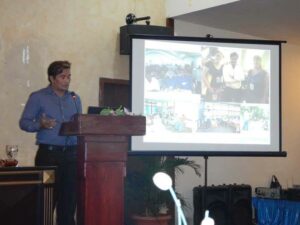
The second session of the day focused on ecology research. Presenters included Dr. Andrew Marshall (founder of the Gunung Palung Gibbon and Read Leaf Monkey Project), Dr. Campbell Webb (Yayasan ASRI), Mr. Riyandi (Tanjungpura University), Kobayashi (Indonesia/Japan- REDD+ Project), and Edward Tang (former research assistant and GPOCP Environmental Education Coordinator). The presentations were highly varied, touching on topics including the ecology of mangrove forests, the phenology and productivity of the Gunung Palung rainforest, and the avian diversity of the National Park. Together these presentations highlighted the importance of the entire suite of research that has been done in Gunung Palung over the past 30 years.
To share the GP30+ celebration with the entire local community, on the evening of August 6th we hosted a public gathering at Datok Beach in Sukadana. We opened the evening with performances by two traditional musical groups from Tanjung Gunung, which is the village that anyone hiking into Cabang Panti passes through. This was their first public performance, and the crowd very much enjoyed the music. The audience was then treated to a slideshow presentation by National Geographic photographer, Dr. Tim Laman. For nearly an hour, Tim shared photos and stories about the biodiversity of Gunung Palung with the crowd. His photos highlighted the beauty of this rainforest ecosystem, allowing people to see the National Park through fresh eyes, and – hopefully – inspiring them to protect and conserve the area.
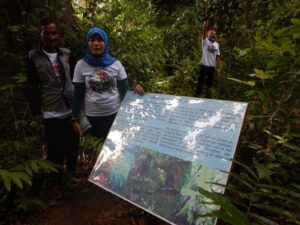
The second day of the Symposium, August 7th, focused on the conservation work being done in and around Gunung Palung National Park. Presentations were given by Cassie Freund (Program Director, GPOCP), Etty Rahmawati (Yayasan ASRI), Budi Sempurna (Gunung Palung National Park Bureau), Yoshikura (Indonesia/Japan-REDD+ Project), and Juanisa Andiani (International Animal Rescue). These talks showcased the range of conservation work being done in the GP landscape, including environmental education, promoting sustainable livelihoods, and mitigating human-orangutan conflict. After a break for lunch, all of the Symposium participants were invited to GPOCP’s Bentangor Environmental Education Center in Pampang Harapan village for a tour of our educational facilities and to watch a demonstration by our Non-Timber Forest Product artisans. Many of the conference guests had never been to Bentangor before and it was great to have the chance to showcase our conservation center. GPOCP staff led field trips, the artisans taught participants how to make baskets and jewelry, and our guests even had a chance to support rainforest conservation by purchasing traditional handicrafts!
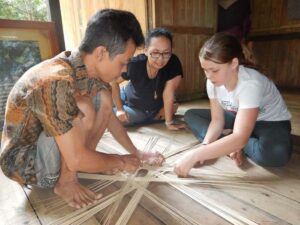
Following the two day Symposium we were thrilled to have many of the conference participants come visit Cabang Panti Research Station – some for the first time and some after more than 20 years away. Among our special guests were GPOP board members, Dr. Barita Manullang and Pak Darmawan Liswanto (Flora & Fauna International). We also were very honored to have Dr. Dadan Kusnandar, Dean of the Faculty of Mathematics and Natural Sciences at West Kalimantan’s University of Tanjungpura (UNTAN), and UNTAN Docent (Lecturer), Pak Riyandi, join us, along with Dr. Wendy Erb from Rutgers University. It was a homecoming for many former researchers, including study site founder, Dr. Mark Leighton (Harvard University), Dr. Lisa Curran (Stanford University) and her Indonesian counterpart, Dessy Rasel Ratnasari (Simpur Hutan), Dr. Dan Gavin (University of Oregon) and Andrea Johnson (Environmental Investigation Agency). Current researchers and graduate students, as well as additional Gunung Palung National Park Bureau staff members, a team from the forest patrol unit, field assistants, and Cabang Panti staff were also in attendance. On the first night we set a record for the number of people at dinner: 57!
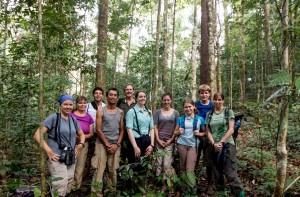
One of the highlights of the week was a “Habitat Walk” by Dr. Mark Leighton. As Mark explained during his plenary address at the symposium, he chose to establish the research site in Gunung Palung National Park, and specifically the Cabang Panti location, because of its incredible habitat diversity. In just a few hours one can traverse peat swamp, freshwater swamp, alluvial bench, lowland sandstone, lowland granite, upland granite and montane habitats. This gives researchers the opportunity to study the unique animal and plant diversity found within each forest type and to do comparative studies between habitats. During his demonstration, Mark explained how each habitat was formed, what made it unique, how to identify it and which animals and plants were found there. Many of these habitats, such as the alluvial bench forest, are increasingly rare in Southeast Asia, because they are suitable for human settlement.
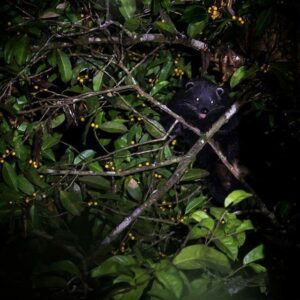
The week was filled with incredibly lucky animal sightings by our visitors. On her first day in Cabang Panti, Dr. Wendy Erb, a primatologist at Tuanan Research station in Central Kalimantan, found and followed an orangutan to its night nest on her own. On her way home in the dark she saw a sun bear! Dr. Dan Gavin caught a great view of our dominant male orangutan, Codet, the only sighting of him by anyone all month. Finally, on the last night of the week-long visit, many of us went on a short night walk close to camp, and were lucky enough to spot a rarely-seen binturong in the forest. Other special events included an evening bonfire on the beach with stories from Cabang Panti lore told all around, long hikes through the forest, and catching up with old friends. Some of the attendees also hiked up to the 948-meter top of Gunung Palung, called “GP 90” which indicates the 4.5 km trail marker. It was a week full of many happy smiles, sweaty hugs and the creation of new memories.
Overall GP30+ was a huge success. We’re thankful to all of the participants who traveled to West Kalimantan to attend the Symposium. We are especially grateful to the Wenner-Gren Foundation, who made the conference possible through their Engaged Anthropology Grant. Hopefully we can do it again in five years!